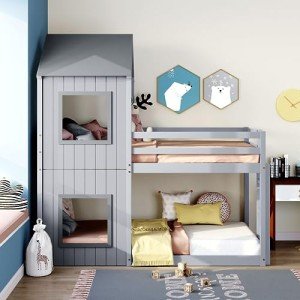Bunks: The Versatile Space-Saving Solution for Modern Living
In today's hectic world, where city living areas are diminishing and the need for versatility and practicality is increasing, bunks have emerged as a popular service. Bunks are not simply a type of bed; they represent an advanced technique to optimizing space, promoting social interaction, and offering comfy sleeping plans. This short article will explore the various types of bunks offered, their advantages, and how they can change both little and big home.
Comprehending Bunks: What Are They?
Bunks, frequently referred to as bunk beds, are two or more beds stacked on top of each other. They are created to conserve flooring space, making them perfect for children's spaces, hostels, and even adult living scenarios. Bunk beds are available in various styles and configurations, from conventional designs to modern, designer analyses.
Kinds of Bunks
| Type of Bunk | Description |
|---|---|
| Twin-over-Twin | 2 twin beds stacked on top of each other. Perfect for kids sharing a room. |
| Twin-over-Full | A twin bed on leading and a larger full bed on the bottom. Toddler Bunk Beds deedrehs.top for accommodating guests. |
| Full-over-Full | Two full-sized beds stacked together. Perfect for older kids or adults. |
| L-Shaped Bunk Bed | Beds are set up in an L shape, permitting a corner placement and included space beneath. |
| Loft Beds | Just the leading bunk is present, leaving space for a desk, couch, or storage beneath. |
| Triple Bunk Beds | 3 beds stacked vertically, outstanding for making the most of vertical space. |
Benefits of Using Bunks
- Space Efficiency: Bunks are developed to make use of vertical space, making them perfect for small bedrooms or homes where flooring space is limited.
- Economical: Investing in a bunk bed can be more cost-effective than purchasing several separate beds, especially for growing families or those with frequent visitors.
- Versatile Designs: Many bunks come with add-ons, such as desks, storage drawers, or futons, enabling versatile use of the area.
- Social Interaction: Bunk beds invite friendship amongst siblings and pals, fostering a sense of connection.
- Innovative Use of Space: Bunk beds encourage imagination in room design, permitting lively themes and vibrant decor that can make a bed room feel special and welcoming.
Practical Considerations
- Height Limitations: When picking a bunk bed, it is necessary to consider the height of the ceiling in the space. Measure the space to ensure there is appropriate clearance above the leading bunk for security and convenience.
- Weight Restrictions: Each bunk has a particular weight limitation. Parents must examine the weight of those using it, especially when it comes to adults or much heavier teenagers sharing the bed.
- Security Features: Features such as guardrails, sturdy ladders, and security accreditations are essential for ensuring the bunk bed's safety, especially for more youthful users.
Bunks for Various Living Situations
Family Homes
In household homes, bunks use a useful option for siblings sharing a room or accommodating sleepovers. Bunk beds can be stylishly integrated into a kid's space while providing adequate room for play.
Hostels and Vacation Rentals
For hostels and trip leasings, bunk beds optimize sleeping arrangements without jeopardizing comfort. Such setups use a cost-effective way to accommodate a larger number of visitors.
College Dormitories
In college dormitories, bunks help maximize the restricted square video footage offered, permitting more room to socialize and study.
Small Apartments
In little metropolitan houses, lofted bunk beds produce additional space for living areas, work areas, or storage, making life more manageable in compact environments.
Upkeep and Care of Bunks
Preserving a bunk bed is important for guaranteeing its durability. Here are a few ideas:
- Regular Inspections: Check for any loose screws or bolts and tighten them as necessary.
- Tidiness: Dust and tidy the bunks routinely to prevent allergens and guarantee a clean sleeping environment.
- Mattress Care: Use a quality mattress protector to keep hygiene and extend the life of the bed mattress.
- Age Appropriateness: Upgrade to a larger, more strong bunk as kids grow or when the present arrangement no longer meets the requirements of its occupants.
Frequently Asked Questions (FAQs)
1. Are bunk beds safe for kids?
Yes, bunk beds can be safe for children if they are constructed with security features like guardrails and a steady ladder. Always monitor younger kids when they are utilizing bunk beds.
2. What age is proper for a child to sleep on the leading bunk?
The majority of manufacturers recommend that kids under the age of six should not sleep on the upper bunk due to security concerns.
3. How much weight can bunk beds normally hold?
Weight capacities differ based on the style and materials however normally range from 200 to 400 pounds. Constantly check the maker's guidelines.
4. Can bunk beds be separated into two single beds?
Many bunk beds are developed to be convertible, enabling them to be separated into 2 individual beds. It's important to check the product specs before purchasing.
5. What sort of bed mattress is best for a bunk bed?
A medium-firm bed mattress is often advised as it provides sufficient assistance without being too heavy or soft, which can posture security issues.
Bunks are more than simply beds. They are ingenious space-saving options that accommodate the requirements of modern living. With numerous styles offered, they supply comfort and performance for households, visitors, and people alike. By focusing on security and maintenance, owners can ensure that their bunk beds become a cherished part of their living areas for lots of years to come. Whether for playful children or accommodating guests, bunk beds provide an elegant and practical option to the obstacle of restricted space.

